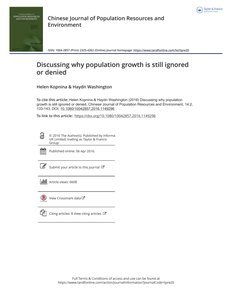There is increasing evidence that humans are not living sustainably. There are three major drivers of the unsustainable approach: population, consumption and the growth economy. There is widespread denial about these issues, but they clearly need to be addressed if we are to achieve any of the possible sustainable futures. The first and second versions of the ‘World Scientists Warning to Humanity’ both highlight the problem of increasing human population, as do the IPCC and IPBES reports. However, all have been largely ignored. The size of an ecologically sustainable global population is considered, taking into account the implications of increasing per capita consumption. The paper then discusses the reasons why society and academia largely ignore overpopulation. The claim that discussing overpopulation is ‘anti-human’ is refuted. Causal Layered Analysis is used to examine why society ignores data that do not fit with its myths and metaphors, and how such denial is leading society towards collapse. Non-coercive solutions are then considered to reach an ecologically-sustainable human population. LinkedIn: https://www.linkedin.com/in/helenkopnina/
MULTIFILE

This study will examine whether voluntary work or an internship in a developing country contributes to the development of global citizenship among young people. For the purpose of this study, global citizenship will be defined as a combination of social awareness and possessing international competencies. For a period of four years, a group of 1000 participants between 14 and 25 years old was followed using online self-administered surveys, surveys conducted within the social environment and a smaller number of in-depth interviews. Data collection took place prior to an internship or voluntary work in a developing country, following their return, and six months after their return. Almost all of the international competencies that according to prior research are required to be able to function effectively when communicating with people from a different cultural background were found to have increased during their their stay abroad. Only reading and writing skills in the local language of the area were shown not to have improved. The greatest amount of improvement occurred in the area of intercultural competencies, namely attitude, knowledge, behaviour and skills. Following their stay abroad, the personal and social competencies of participants were also shown to have increased. Relatively speaking, their international professional and academic skills improved the least. Despite this, following the return from voluntary work or an internship in a developing country, a larger number of participants were shown to be exhibiting a socially responsible attitude with an understanding of interdependence, equality of all people and a shared responsibility for solving global issues, and expressed this more frequently in their behaviour. In addition, an increase in flexibility, cultural empathy, social initiative and emotional stability among participants was observed. What essentially characterises the participants according to the in-depth interviews is the ability they have developed to look through someone else’s eyes at their own culture and living conditions in the Netherlands and to use their improved self-confidence to live a more socially aware life and/or engage in international activities after their return from abroad.
DOCUMENT

Due to a number of factors outlined in this article, the issue of population growth is excluded from the sustainability discussion. In this article, we explore some of the ethical presumptions that underlie the issues linking population growth and sustainability. Critics argue that action to address population creates social and economic segregation, and portray overpopulation concerns as being “anti-poor,” “anti-developing country,” or even “antihuman.” Yet, de-linking demographic factors from sustainability concerns ignores significant global realities and trends, such as the ecological limits of the Earth, the welfare and long-term livelihood of the most vulnerable groups, future prospects of humanity, as well as the ecosystems that support society. https://doi.org/10.1080/10042857.2016.1149296 LinkedIn: https://www.linkedin.com/in/helenkopnina/
MULTIFILE

The Dutch floriculture is globally leading, and its products, knowledge and skills are important export products. New challenges in the European research agenda include sustainable use of raw materials such as fertilizer, water and energy, and limiting the use of pesticides. Greenhouse growers however have little control over crop growth conditions in the greenhouse at individual plant level. The purpose of this project, ‘HiPerGreen’, is to provide greenhouse owners with new methods to monitor the crop growth conditions in their greenhouse at plant level, compare the measured growth conditions and the measured growth with expected conditions and expected growth, to point out areas with deviations, recommend counter-measures and ultimately to increase their crop yield. The main research question is: How can we gather, process and present greenhouse crop growth parameters over large scale greenhouses in an economical way and ultimately improve crop yield? To provide an answer to this question, a team of university researchers and companies will cooperate in this applied research project to cover several different fields of expertise The application target is floriculture: the production of ornamental pot plants and cut flowers. Participating companies are engaged in the cultivation of pot plans, flowers and suppliers of greenhouse technology. Most of the parties fall in the SME (MKB) category, in line with the RAAK MKB objectives.Finally, the Demokwekerij and Hortipoint (the publisher of the international newsletter on floriculture) are closely involved. The project will develop new knowledge for a smart and rugged data infrastructure for growth monitoring and growth modeling in the greenhouse. In total the project will involve approximately 12 (teacher) researchers from the universities and about 60 students, who will work in the form of internships and undergraduate studies of interesting questions directly from the participating companies.
A fast growing percentage (currently 75% ) of the EU population lives in urban areas, using 70% of available energy resources. In the global competition for talent, growth and investments, quality of city life and the attractiveness of cities as environments for learning, innovation, doing business and job creation, are now the key parameters for success. Therefore cities need to provide solutions to significantly increase their overall energy and resource efficiency through actions addressing the building stock, energy systems, mobility, and air quality.The European Energy Union of 2015 aims to ensure secure, affordable and climate-friendly energy for EU citizens and businesses among others, by bringing new technologies and renewed infrastructure to cut household bills, create jobs and boost growth, for achieving a sustainable, low carbon and environmentally friendly economy, putting Europe at the forefront of renewable energy production and winning the fight against global warming.However, the retail market is not functioning properly. Many household consumers have too little choices of energy suppliers and too little control over their energy costs. An unacceptably high percentage of European households cannot afford to pay their energy bills. Energy infrastructure is ageing and is not adjusted to the increased production from renewables. As a consequence there is still a need to attract investments, with the current market design and national policies not setting the right incentives and providing insufficient predictability for potential investors. With an increasing share of renewable energy sources in the coming decades, the generation of electricity/energy will change drastically from present-day centralized production by gigawatt fossil-fueled plants towards decentralized generation, in cities mostly by local household and district level RES (e.g PV, wind turbines) systems operating in the level of micro-grids. With the intermittent nature of renewable energy, grid stress is a challenge. Therefore there is a need for more flexibility in the energy system. Technology can be of great help in linking resource efficiency and flexibility in energy supply and demand with innovative, inclusive and more efficient services for citizens and businesses. To realize the European targets for further growth of renewable energy in the energy market, and to exploit both on a European and global level the expected technological opportunities in a sustainable manner, city planners, administrators, universities, entrepreneurs, citizens, and all other relevant stakeholders, need to work together and be the key moving wheel of future EU cities development.Our SolutionIn the light of such a transiting environment, the need for strategies that help cities to smartly integrate technological solutions becomes more and more apparent. Given this condition and the fact that cities can act as large-scale demonstrators of integrated solutions, and want to contribute to the socially inclusive energy and mobility transition, IRIS offers an excellent opportunity to demonstrate and replicate the cities’ great potential. For more information see the HKU Smart Citieswebsite or check out the EU-website.

The main aim of KiNESIS is to create a Knowledge Alliance among academia, NGOs, communities, local authorities, businesses to develop a program of multidisciplinary activities in shrinking areas with the aim of promoting and fostering ideas, projects, workforce, productivity and attractiveness. The problems affecting peripheral territories in rural or mountain areas of the interior regions, compared to small, medium or large population centres and large European capitals, are related to complex but clear phenomena: the emigration of young generations, abandonment and loneliness of elderly people, the loss of jobs, the deterioration of buildings and land, the closing of schools and related services, the disappearance of traditions and customs, the contraction of local governments, which in absence of adequate solutions can only generate worse conditions, leading to the abandonment of areas rich in history, culture and traditions. It is important that these communities - spread all over Europe - are not abandoned since they are rich in cultural traditions, which need to be preserved with a view to new developments, intended as "intelligent" rebirth and recovery.The focus of KiNESIS is to converge the interest of different stakeholders by recalling various skills around abandoned villages to make them "smart" and "attractive".Keeping in mind the triangular objectives of cooperation and innovation of research, higher education and business of the Knowledge Alliance action, the project aims are: i) revitalising depopulated areas by stimulating entrepreneurship and entrepreneurial skills; ii) creating local living laboratories, shared at European level, in which the exchange of knowledge, best practices, experiences can help promote social inclusion and entrepreneurial development;iii) experimenting new, innovative and multidisciplinary approaches in teaching and learning; iv) facilitating the exchange, flow and co-creation of knowledge at a local and global level.